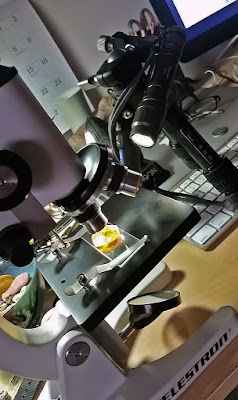“Why has not anyone seen that fossils alone gave birth to a theory about the formation of the earth, that without them, no one would have ever dreamed that there were successive epochs in the formation of the globe.”
― Georges Cuvier
― Georges Cuvier
As best as I can remember, fossil collecting was my first foray into Natural History―I recall finding my first specimens along railroad tracks by Lake Monona when I was 4 or 5 years old. I think I might even still have some of them stashed away in boxes in my storage compartment. I have collected in quarries in southern Wisconsin and also along the shores of Nova Scotia. Fossils I've found myself are certainly more special, but I also purchase them from places like Burnie's Rock Shop in Madison and FossilEra online.
Last year I purchased a series of Amber Insect Fossils and used my macro setup and microscope to take high-resolution photographs of them. I think the results are staggering and it's a fun thing to do photography-wise when the weather is gloomy. These particular specimens (an ant and cicada nymphs) were taken from 44 million year-old (Eocene) amber from the Baltic region. Amber preserves ancient critters in incredible detail, down to veins in insect wings and the lenses on compound eyes.
The oldest insect fossils are over 400 million years old―a few hundreds million years before the first primates arrive on the scene. While insect lineages have radiated and changed over time, their basic structure hasn't―six legs; head, thorax, abdomen. It's one of the fascinating things to consider when I photograph living insects today―how far back do they go? A cursory check reveals that the oldest tiger beetle fossils dates back over 100 million years. Oh, how I would love to have an amber-encased tiger beetle!
Via macro lens:
Via microscope:
All images © 2020 Mike McDowell







